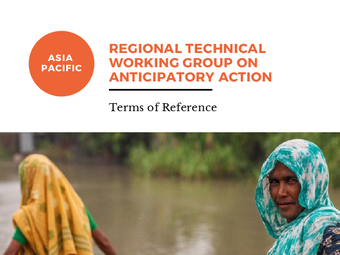Categories
Asia-Pacific Technical Working Group on Anticipatory Action
The Asia-Pacific region is one of the most diverse in the world. It’s home to nearly 4.5 billion people – some 60 per cent of the global population – with roughly 2,300 languages and dialects between them. Its geography reflects this diversity, from the high plateaus of Afghanistan to the tropical islands of Fiji and the wide-open grasslands of the Mongolian steppe.
The region is also one of the most hazard-prone: some 70 per cent of the world’s disasters occur here. And they hit particularly hard for families with limited resources, who often belong to minority groups, living in remote areas or on the fringes of cities. For them, the unending cycle of cyclones, floods, droughts and heat waves can be relentless.These hazards are also getting more frequent and intense, thanks to climate change.
The impacts of conflict and economic problems can be equally taxing, especially if these coincide with hazards. It’s no coincidence that some of the most hazard-prone communities in the region are also among the world’s poorest, as crisis after crisis strips away at the hard-earned assets of families who have limited means to protect themselves and limited time to recover between shocks.
Anticipatory action in the Asia-Pacific region
While we may not entirely prevent disasters from happening, we can minimize the consequences by acting early. Anticipatory action is an approach that combines impact-based forecasting, anticipatory (or early) actions, ex-ante financing, and efforts to strengthen countries' operational capacity to implement actions ahead of a hazard. It has been widely accepted and adopted by humanitarian partners and governments in the region as a way to better protect people's lives and livelihoods, and to maintain their self-reliance.
By using better forecasting models, pre-positioning resources and mapping the most vulnerable groups, anticipatory action has the potential to prevent people from falling further into destitution and sustain development gains. Consider, for example, a family’s ability to keep their children in school with the income they derive from the livestock they were able to protect through anticipatory action, or how a community can maintain a basic level of nutrition, even in challenging times. In short, by being a timely form of disaster risk management, anticipatory action reduces losses and suffering, and protects progress.
As interest in anticipatory action grows in the Asia-Pacific, so does the need for information-sharing, coordination and joint advocacy. There is currently a gap in terms of regional partnerships convening the humanitarian, development and climate-resilience communities, and a need to draw on evidence and best practice to drive and unify standards, while also increasing investment. The Asia-Pacific Technical Working Group on Anticipatory Action aims to address this gap and promote a regional approach to knowledge-sharing and cooperation.
Key functions
The main functions of the group are to:
- develop a common framework for, and further the intellectual underpinning of, anticipatory action to ensure technical rigour in the region; this includes developing definitions and standards
- promote the scaling up of collective anticipatory action efforts
- provide technical support to joint interagency efforts
- support governments and partners to develop collaborative, sustainable and holistic anticipatory action systems
- generate joint evaluation methodologies and evidence, and disseminate the lessons learned from these
- collaborate on events, knowledge products and workshops
- coordinate and engage in joint efforts to mobilize resources for anticipatory action, including flexible financing
- provide technical materials, tools and templates to guide countries on setting up their own national anticipatory action systems
- support the linking of anticipatory action to other key themes, such as shock-responsive social protection, cash, social inclusion and climate resilience, among others
- provide regional early-warnings updates, specifically for El Niño/La Niña events; these will be presented at regional groups such as the Emergency Preparedness Working Group, the Inter-Agency Standing Committee Regional Network, and the regional Climate Outlook Forums
- provide technical assistance on anticipatory action to regional bodies, both in terms of practical and policy uptake; these include the Association of Southeast Asian States (ASEAN), the ASEAN Coordinating Centre for Humanitarian Assistance on Disaster Management, the South Asian Association for Regional Cooperation, and the Pacific Resilience Partnership, among others.


